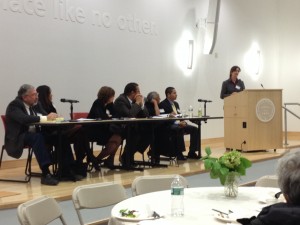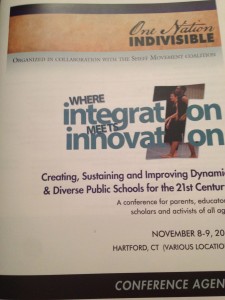
(Source: Veronica Armendariz)
11/8/13
On November 8th 2013, held a luncheon for the school integration conference “Where Integration Meets Innovation” (by the group One Nation Indivisible)with panelists discussing the progress in educational equality and the changes being made to keep education equal for all today. The panelists spoke of the Sheff v. O’Neill lawsuit, the changes that have been made with the decision of that case, and the other ways to improve educational equality in the Hartford region. Robert Cotto Jr., re-elected member of the Hartford Board of Education and senior policy fellow at CT Voices, shared his thoughts and his vision for education in the Hartford region and linked this vision to his own experience in the Connecticut educational system.
Cotto begins to explain his vision for education in Hartford by reflecting on his experience attending high school in Wethersfield when Sheff v. O’Neill was occurring. He spoke of how his parents wanted him to attend a high school that had better resources, smaller class sizes, and means to give him a proper education. Cotto talks about how he was able to receive individualized attention when he needed it and a safe and clean working environment during the school year. When he thinks of Hartford schools at the time, he says that they had outdated material, very poor facilities, and little resources to offer students attending school there. Looking back on this, Cotto talks about how grateful he was to have attended a school that “had everything Hartford didn’t”, and he wants the same for the children of Hartford today.
With this idea in mind, Cotto discusses the role of Sheff schools in the Hartford region and the types of opportunities it provides Hartford’s students. Cotto states that the Sheff schools have all of the resources that children need in order to succeed today. However, there is another type of program similar to that but with a very important difference: the open choice program. Cotto says that the open choice program gives parents the same option in choosing where their child will attend school, but it does not have a plethora of resources like Sheff does. Cotto’s main concern mostly stems from the integration of both Sheff and open choice because of the lack of resource from open choice. With this, he would see success in terms of equality as opposed to how everyone else sees success: rising test scores. In considering the integration of the two, Cotto would want to see coordination in school choice and managing kids from different regions around Hartford so that there is a better sense of who is involved and who is a part of school choice. Also, this coordination would then allow for people to see if there are appropriate resource in schools, quality teachers in each classroom, and updated facilities appropriate to sustain the staff and student body.
However, there is a problem in how education functions in the Hartford region. Cotto discusses how the main leaders in education in the city of Hartford are elected by the people. He continues on to describe the way people place a high emphasis on having their child attend a magnet school and how popular magnet schools are. Integration, on the other hand, is a very unpopular idea to many Hartford residents. Therefore, the idea of integrating Sheff and open choice would not be particularly popular among the masses. The true challenge, in Cotto’s eyes, in making this integration is how would we connect and engage people in both the idea of magnet schools and integration working hand in hand effectively to their standards.



